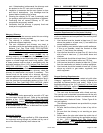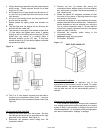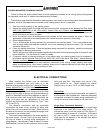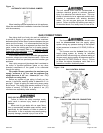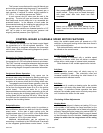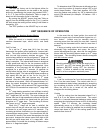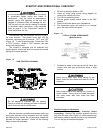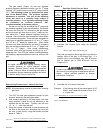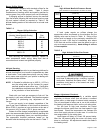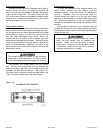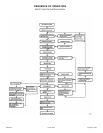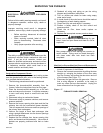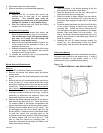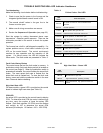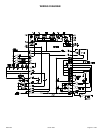
Burner Orifice Sizing:
The furnace is supplied with standard orifices for the
gas shown on the rating plate. Table 6 shows
combinations of heating values and specific gravities for
various gases, from which proper input can be obtained.
If changing orifices is required, remove the manifold
from the furnace (following the instructions found on page
24) and replace orifices as required by Table 6, the
altitude derating section of this instruction or as local code
dictates.
TABLE 6
Burner Orifice Selection
Type of Gas@Manifold Press.
(Heating Value-Specific Gravity)
Btu per Cu. Ft.
Orifice
Size
(Drill #)
Natural Manifold Press.= 3.5"w.c.
800-0.6
900-0.6
1000-0.6
1100-0.6
40
41
42
43
Propane Manifold Press.= 10"w.c.
2500-1.53
54
After securing the manifold assembly, replace all
other components and/or wiring, being sure that all
connections and screws are tightened properly.
Altitude Derating:
The following information is provided as guidelines for
altitude derating and is not meant to supersede any state
or local codes. Local codes have priority over any others
and in some case might limit your options in dealing with
an altitude derate situation.
NOTE: In Canada for altitudes up to 4500 ft. (1372 m)
see the rating label on this furnace for proper
manifold pressure and orifice size. Certification
for installations at altitudes over 4500 ft. (1372 m)
is the jurisdiction of local authorities.
Check with your local gas company to find out if the
gas supply in your area is derated. Gas deration negates
the necessity of performing any adjustment on the
furnace.
If your gas supply is not derated, regardless of the
type of gas used, installation of this furnace at elevations
above 2,000 ft. requires an input reduction at the rate of
four percent (4%) for each 1,000 ft. above sea level.
Unless an orifice change is specified by an applicable
code, the recommended method of altitude derating this
furnace is to appropriately lower your manifold pressure.
The appropriate manifold pressures based on the
elevation and the heating value can be found in Table 7.
TABLE 7
High Altitude Manifold Pressure Derate
(with standard 42 orifice Natural / 54 orifice LP sizes)
Altitude
(Feet)
*Heating Value of Natural Gas
(BTU/FT3)
LP
Propane
900 950 1000 1050 1100 2500
0-999 4.32 3.88 3.50 3.16 2.84 10
1000-1999 4.32 3.88 3.50 3.16 2.84 10
2000-2999 3.67 3.29 2.97 2.68 2.41 8.46
3000-3999 3.38 3.04 2.74 2.47 2.22 7.74
4000-4999 3.11 2.79 2.52 2.27 2.04 7.05
* Heating-Value based on atmospheric pressure of 30 inhg and 60°F temperature.
If local codes require an orifices change the
appropriate orifice size based on the elevation and the
heating value can be found in Table 8. Sizing of the
orifice must be based on the previously mentioned 4%
derate for each 1,000 feet for installations at/or above
2,000 feet rule and the orifices must be drilled in such a
way as to assure concentricity. Hand drilling of orifices
is unacceptable.
TABLE 8
High Altitude Orifice Size Derate
Altitude
(Feet)
*Heating Value of Natural Gas
(BTU/FT3)
LP
Propane
900 950 1000 1050 1100 2500
2000-2999 N.C. N.C. 43 43 44 N.C.
3000-3999 N.C. N.C. 43 44 44 N.C.
4000-4999 43 43 44 44 45 55
* Heating-Value based on atmospheric pressure of 30 inhg and 60°F temperature.
Hand drilling of orifices is never acceptable since it
could lead to delayed ignition, overfiring, improper
combustion, flashback and flame rollout. All these
conditions could lead to a fire hazard and bodily
harm, or loss of life.
Blower Adjustment Checkout:
This furnace is equipped with a variable speed
circulation air blower motor that will deliver a constant
airlfow within a wide range of external static pressures.
The unit as shipped is factory set to run at the middle of
the heating rise range as shown on the unit rating plate.
For low heat to high heat transition the control
changes the blower speed from low heat speed to high
heat speed. Check the temperature rise between the
return and supply plenums to make sure it is within the
rise range shown on the rating plate.
Heat blower off delay is a fixed 180 second delay.
After the 180 second delay the motor will slowly ramp
down to a soft stop. N0 adjustments need to be made in
the heating mode.
20571201 Issue 0527 Page 21 of 28



